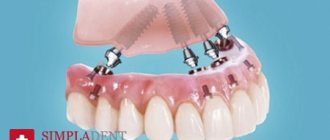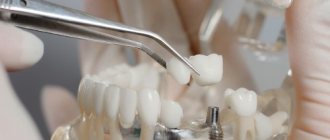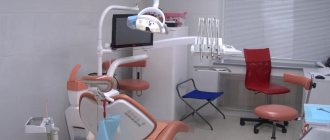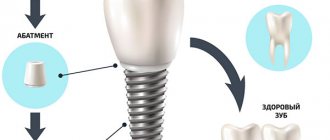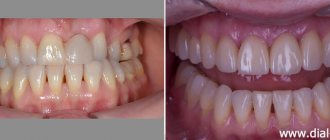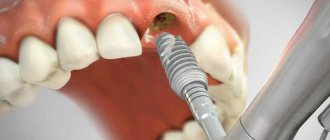Publication date: 03/19/2021
It seems that dental implantation takes a long time and it is impossible to make teeth turnkey in 1 day. However, innovative technologies and modern materials are capable of even this. Restoring lost teeth and making them indistinguishable from real ones is a feasible task for today’s medicine.
A beautiful, attention-grabbing smile is an indicator of health and status. It gives self-confidence to its owner. But what to do if not all the teeth were saved, or most of them are destroyed or are subject to severe caries. In such cases, treatment and subsequent implantation come to the rescue. This way you can get your perfect smile back in 1 day.
Indications and contraindications for installing implants in one day
This type of prosthetics allows you to either restore an entire row of teeth or make a prosthesis for just one tooth. This method is recommended for:
- periodontal disease
- irritation of bone tissue
- receding gums
- complete absence of teeth
This technology allows you to insert teeth in one day and immediately return a beautiful smile and the ability to eat comfortably.
One-time implantation is especially good in cases of complete or almost complete absence of teeth, when there is no time for a long wait and you want to quickly return to a full life.
There are certain situations in which implantation in one day is not possible. A preliminary examination will help identify these indications, without which medical intervention should not begin. Contraindications to dental implantology are:
- advanced osteoporosis
- oncological diseases
- connective tissue pathologies
- poor blood clotting
- immune system disorders
- decompensated diabetes
- acute infectious diseases
- pregnancy and lactation
If the above indications are present, the doctor will recommend an alternative method of restoring the dentition.
What is better: classic two-stage implantation or one-stage implantation?
It is, of course, best to restore the front teeth using a one-stage technique, but the presence of contraindications does not always allow it to be carried out. In such cases, we resort to a two-stage technique, which is also one of the most effective methods of prosthetics. Therefore, it is impossible to call any of the above methods the best. It is important to understand which one will be most acceptable and safe for the patient. However, let us outline all the advantages of one-stage implantation:
- the ability to complete the entire procedure in a short period of time;
- use of local anesthesia only;
- the ability to carry out installation, even with complete or partial absence of teeth;
- absence of invasive and painful surgical intervention;
- the possibility of performing the procedure even with a small amount of bone tissue;
- installation of an implant immediately after tooth extraction;
- the ability to perform chewing movements on the day of the procedure;
- relatively low cost.
Stages of treatment
Implantation in 1 day is prosthetics immediately after the installation of implants. The issue of aesthetic and practical function of teeth is resolved in a short time. This operation does not require bone grafting. Implants can be installed not only in the spongy substance, but also in deeper layers of bone. In addition, the pins can be placed at an angle. This technology allows you to avoid injury to nerves, blood vessels and paranasal sinuses.
The installation of implants is carried out in one visit to the dentist, but to achieve the final result, this procedure requires preparatory measures. The whole operation takes place in several stages:
- At the first session, the doctor conducts diagnostics, determines the current condition of the patient’s teeth, possible contraindications, and performs a computed tomography scan. If preliminary treatment is necessary, it must be carried out. Otherwise, it will not be possible to install new teeth. At the same appointment, a model of future prostheses is created. The waiting period for future implants ranges from 1 to 7 days. Next, the doctor chooses the method of performing the procedure, selects the pins and makes the crowns that will be installed.
- The second stage is the work of installing the metal pins themselves. It is performed under anesthesia in one procedure. At the site where the implants are installed, an incision is made in the gum and pins are screwed into the prepared recess. Then the gum is sutured. Next, a temporary prosthesis is placed on the implanted implants. It is made of acrylic, so it is quite light, which contributes to comfortable wear and rapid healing.
The permanent prosthesis is installed 6-12 months after implantation. This time is enough for the implant to fuse with the bone.
Implantation with immediate loading using the “All-on-6” technique. Clinical experience.
Authors: implantologist-surgeon V.L. Sheleg, orthopedic dentist A.P. Dobritsky.
In our article, using a clinical example, we would like to share our experience, which includes the rehabilitation of patients with partial and complete edentia (lack of teeth) using the “All-on-6” method . This method involves the manufacture and fixation of fixed dentures with supports on dental implants as soon as possible after implantation.
We tried to describe in detail who is recommended for implantation using the “All-on-6” method, note the positive characteristics of this type of rehabilitation and show all the stages of treatment that were carried out in our clinic.
If we take into account the data provided by the World Health Organization, then from 40 to 70% of people are partially edentulous. In the Republic of Belarus, complete adentia according to L.G. Borisenko occurs in the age group 65–74 years old – 14.7+/-1.70% and in people over 75 years old – 26.3+/-0.18% [1].
At the same time, partial adentia occurs more often in middle age, and complete adentia is more often recorded in older people. There are many more methods for treating the absence of 1 - 2 teeth than for treating complete edentia. And if previously patients with complete absence of teeth were offered exclusively complete removable plate dentures, now the implantation method is becoming more and more popular.
Smile before patient treatment by KANO clinic specialists
Smile after patient treatment by KANO clinic specialists
However, implantation is an expensive and time-consuming treatment method due to the frequent need to build up bone tissue, and therefore, according to certain criteria, it is not suitable for every patient. But implantation in dentistry does not stand still; new alternative treatment methods are constantly being developed. And so, in the late 90s of the last century, doctor Paulo Malo developed the concept of treating patients with completely edentulous teeth using the “All-on-6” method.
Main features of the “All-on-6” technique.
The main features of this technique are:
- installation of implants into the patient’s existing bone tissue, bypassing the anatomical formations of the upper and lower jaws (maxillary sinus and mandibular nerve canal);
- does not imply the presence of a bone tissue growth stage;
- the ability to often combine installation of implants and removal of remaining teeth into one operation;
- installation of a fixed prosthesis supported on implants as soon as possible after surgery (1-5 days), which significantly improves the aesthetic and functional rehabilitation of the patient.
This method is indicated for patients with complete absence of teeth on one or two jaws, or for patients who are indicated for the simultaneous removal of all remaining teeth. [2, 3, 4] “All-on-6” implantation is recommended for patients with close proximity of the maxillary sinuses, osteoporosis, uneven bone tissue atrophy and periodontal tissue disease. [2, 3, 4] This means that it is indicated in cases where classical implantation techniques are not possible, or a successful treatment result is not guaranteed.
The essence of the “All-on-6” operation is that after making a clinical diagnosis and discussing all the nuances with the patient, 6 implants are installed on each jaw. In the upper jaw, 2 implants are installed in the frontal region at a right angle, that is, vertically. [3, 4, 5,] The remaining 4 implants are installed in the lateral parts of the jaw, at certain angles, bypassing the maxillary sinus. In the lower jaw, implants are installed bypassing the mandibular nerve, mainly at right angles. [3, 4, 5]
Alignment of the axes of insertion and fixation of the prosthesis (shafts for screw fixation) is carried out by installing angular multi-unit abutments. After that, the orthopedic dentist takes impressions from which the future metal-acrylic bridge will be made.
Description of the case. Let’s analyze the “All-on-6” technique using this clinical case:
Clinical situation of the patient at the time of contacting the KANO clinic
Patient N. turned to specialists at the KANO clinic with complaints of unsatisfactory aesthetics, difficulties with chewing food, and mobility of teeth on both jaws.
After a thorough collection of complaints, history and examination, the patient was sent for a computed tomography scan. During the examination, tooth mobility of 2-3 degrees, deep periodontal pockets, and numerous inflammatory foci of periodontal tissues were revealed. A decision was made to rehabilitate the patient using the “All-on-6” method.
CBCT fragment of a patient's jaws
During the operation, under local anesthesia, the most atraumatic removal of all teeth, de-epithelialization of the edges of the sockets, and installation of dental implants in tooth positions 12-22, 14-24, 17-27, 32-42, 34-44, 37-47 were performed. Primary implant stability of at least 30N/cm2 was achieved in the upper jaw by means of bicortical fixation.
Control x-ray after installation of 12 implants on the jaws
The photograph of the upper jaw was taken after the installation of implants, multi-unit abutments and gingival cuff formers
The photograph of the lower jaw was taken after the installation of implants, multi-unit abutments and gingival cuff formers
Immediately after the operation, the orthopedic dentist installed multi-unit abutments in such a way that the shafts of the fixing screws for the orthopedic structure were as parallel as possible and extended onto the palatal surface of the incisors and the chewing surface of the lateral teeth. Impressions were taken from both jaws using an individual tray with impression transfers fixed along an arc. The central relationship of the jaws is fixed using wax rollers using standard methods.
The next day, the stage of checking the design of the prosthesis on a wax roller in the oral cavity, assessing the aesthetics of the smile, speech tests, and the correct position of the teeth and dentition were carried out.
72 hours after the operation, the dentures are fixed in the patient’s oral cavity, the screw shafts are filled with Teflon tape and covered with photo-curing filling material. After which the patient was given recommendations on the use of dentures and oral care. The patient was scheduled for a follow-up visit the next day for final adjustment of the prosthesis, occlusion monitoring and radiographic monitoring.
Control examination and occlusal correction in the oral cavity
Control examination and occlusal correction in the oral cavity
Conclusions:
Thus, I would like to draw a conclusion about the rehabilitation of patients using the “All-on-6” method:
- Fast aesthetic and functional rehabilitation of the patient, which saves the doctor’s time and improves the patient’s psychological state;
- Reliability and stability of the structure due to 6 implants;
- A minimally invasive method, since there are no stages of bone augmentation, and the patient’s rehabilitation is carried out in one surgical intervention;
- Relatively low cost of patient rehabilitation with fixed prostheses supported by dental implants.
X-ray control after treatment
The final result of the work on the 3rd day of patient treatment
Bibliography:
1. Borisenko L.G.//Monitoring of complete secondary adentia among the older and elderly population in the Republic of Belarus. – 2011. 2. Karl E. Misch; translation from English — M.: Reed Elsiver. // Orthopedic treatment based on dental implants. - 2010. - 616 p. 3. Iron A.S.; Yumashev A.V. // Surgical and orthopedic aspects of prosthetics for patients supported by implants with complete secondary adentia. – Bulletin of new medical technologies. Electronic edition. – 2016. – No. 4. 4. Sebastian BM// The All-on-Four Treatment Concept: A Systematic Review. – Clinical implant dentistry and related research. – December, 2014. – 836 – 855. 5. Taruna M.; Chittaranjan B.// Journal of clinical and diagnostic research. — Prosthodontic Perspective to All-On-4® Concept for Dental Implants. – October, 2014 – ZE16–ZE19.
Which implantation method is best to use?
In modern dentistry, there are several methods of implantation with immediate loading. The most popular and affordable is all-on-4. With this protocol, the dentition is replaced with only four pins. Two of them are implanted vertically and two on the sides at an angle.
Using this technology, 12 dental units can be restored at a time. It is well suited for people who are missing all the teeth on one or both jaws. Or they have been preserved, but in such a condition that they only need to be removed. In this case, implantation and removal can be carried out in one session, and the pins can be installed in the holes remaining after extraction.
The all-on-4 protocol is feasible in case of good preservation of bone tissue and in the absence of gum damage. This method is also used for periodontitis and periodontal disease.
A more advanced method of all-on-4 prosthetics is the all-on-6 protocol. The difference lies in the number of pins implanted. The use of two additional implants increases the reliability of the design as a whole. In addition, the use of all-on-6 is possible even with severe atrophy of the spongy substance due to the fact that the pins are installed in a deeper layer of bone.
How does implantation take place and how many days does preparation take?
The sequence of one-stage implantation techniques is identical. The difference lies in the choice of implant models, their number and method of fixation in the bone.
The first step is a comprehensive diagnosis. The doctor must evaluate the condition of both the patient’s dental system and general health to understand whether implantation can be performed and which method is best. A computed tomography scan is required here. Experts note that a panoramic photo is not enough - it is flat and does not show the volume of tissue, so it will be difficult to carry out high-quality planning.
Computed tomography is an important stage in preparation for dental implantation. Photo: Smile-at-Once
Next comes the planning of the operation. The doctor selects the most optimal treatment protocol and suitable brands of implants. Also at this stage the prosthesis is developed. Already thought-out options are agreed upon with the patient—the treatment plan, the appearance of the prosthesis.
“Of course, doctors do not act on the basis of subjective sensations—high-precision computer technologies help us. All patient data is loaded into special programs. With their help, we virtually place implants in the bones, calculate risks, develop surgical stencils for real surgery, and also create a mock-up of the prosthesis. The most interesting part of the preparation for the patient is the virtual modeling of the appearance of the smile according to the canons of the “golden ratio”, so that the prosthesis fits perfectly with the shape of the face and lips, and even improves them. That is, you can immediately see how your smile will change,” comments Ivan Kopylov.
Virtual planning allows you to take into account the smallest details and think through the implantation process.
Photo: Smile-at-Once Next comes the actual implantation, which is carried out in strict accordance with the drawn up plan: the implants are immersed into the bone according to a guide template that specifies the exact location and angle of installation. To do this, it is not even necessary to cut and peel off the gum - it is simply pierced with a special tool to open access to the bone. All surgical procedures are performed on the same day. For the patient, especially at an older age, this is an absolute plus - additional surgical intervention and complex rehabilitation are avoided.
New teeth in 1 day. Fast rehabilitation and fixed dentures immediately after installation of implants. Photo: Smile-at-Once
The final stage, that is, prosthetics, almost merges with the previous one - the prosthesis is installed a few hours after implantation, a maximum of 3-4 days. Such dentures are very different from removable ones, although their purpose is the same - to replace the visible part of the teeth. But non-removable ones are lighter, more aesthetically pleasing, stronger and much more comfortable, since they do not cover the gums and palate, but are held very securely, that is, they do not fly off.
There are several options for prosthetics:
- Teeth in 1 day is a protocol on four or six Nobel implants. Here the prosthesis is prepared in advance, even before the operation, and after installing the implants it is supplemented with metal transfers, adjusted, adapted and securely fixed using special screws. There is no metal base, the prosthesis is quite light, so it does not interfere with the implants’ healing. But there will be certain dietary restrictions - you cannot eat excessively solid foods. After six months, the prosthesis must be replaced with a permanent structure that will last for decades.
- Teeth in 3 days - these are all other protocols, including on four or six Nobel implants. But here the prosthesis is installed differently - it contains a metal base, which plays the role of a splint and connects the implants together. Such a prosthesis requires a longer period of development - hence 3 days after installation of the implants. It costs more, so the price of implantation is slightly higher. But at the same time, it is precisely this prosthesis that allows you to eat almost fully immediately after fixation. Naturally, in the first days the load on the teeth will be dosed, but gradually you need to increase it and move on to regular products.
“There are several technologies for one-stage implantation: All-on-4, All-on-6, Trefoil, zygomatic implantation, basal complex. Options and combinations are also possible within them. That is, missing teeth can be restored in about 30 different ways, even in difficult and complex situations - with periodontitis, diabetes, after oncology. It’s good when a doctor can offer the patient the best choice - both in quality and price. But for this, a specialist must master most techniques - this is the only way to choose the solution that will be the most effective,” notes Ivan Kopylov.
How durable are teeth in 1 day?
The service life of implants using the all-on-4 or all-on-6 method is 15-20 years. With good hygiene and regular visits to the dentist for checkups, these implants can last a lifetime.
They do not require special care. Regular brushing of teeth 2 times a day and rinsing the mouth is sufficient.
Typically, implant manufacturers provide a temporary or lifetime warranty on their products. In addition, some dentists provide a guarantee on their work. Therefore, if, with proper care and regular checks, problems arise, you will not have to pay to fix them.
Advantages of prosthetics in one day
The main advantage of one-stage implantation techniques is that everything goes very quickly. Together with preparation, treatment takes up to 10 days, and basic manipulations take place in 1-3 days. The result is that the patient leaves the clinic with functional teeth, and rehabilitation is easy. This is important for older patients, because many find it difficult to recover from injuries and extensive interventions.
The second advantage is ease of maintenance. Fixed dentures are cleaned with a brush, paste and irrigator, without removing or processing additionally. You can forget about frequent corrections, and replacement of the prosthesis will be required in 15-20 years. In this case, the implants themselves are placed once and for all.
The quality of life increases significantly - fixed structures are worn and felt like your own teeth. They look natural and definitely won’t fall out at the most inopportune moment. That is, from the outside it is impossible to guess that these teeth are not natural. People begin to communicate calmly, forget about pain and discomfort.
Before and after implantation with installation of the prosthesis immediately. Photo: Smile-at-Once
By the way, many people notice that their health is improving. This is influenced by a return to good nutrition. And also the fact that after the removal of decayed teeth, chronic inflammation in the oral cavity also goes away.
How to choose a specialist
The first thing you should pay attention to is the availability of diagnostic equipment in dentistry. If you were sent to another clinic for a CT scan of your teeth and oral cavity, you should think twice. Modern equipment should be in every serious medical center.
Second, no less important, is the doctor’s experience in the field of implantology. Due to the complexity of the process, the specialist must have experience in performing the operation in this particular direction. Before your consultation, try to educate yourself about the different methods of immediate loading implantation and ask enough questions to the specialist to assess his level of professionalism.
Cost of dental restoration in one day and installments
At the Stimul clinic, the turnkey cost starts from 140,000 rubles. Please note that the price of such treatment is influenced by the chosen prosthetic design (namely, the method of its manufacture and the material used), which means that the final cost should be discussed with your doctor. You can make an appointment with a doctor by phone or on the clinic’s website by leaving a request.
At the Stimul Clinic, we don’t want your barrier to healthy teeth and gums to be related to money. After a free consultation, we will provide a complete treatment plan. All treatment options and the corresponding costs will be described in your hands.
We will offer you an installment plan and will be able to check whether it is possible to pay for your treatment over the course of a year directly at the consultation. Just take your passport with you. We will offer you an honest installment plan, which can be arranged without a down payment and interest for 12 months. Why is this good?
- A more profitable treatment option - by installments you can get the treatment you want.
- An easy way to repay - we work with Post Bank and you can repay the debt at any post office.
- Choice of any installment period from 3 to 12 months and any down payment amount.
- We provide installment plans even to non-working pensioners
- Registration takes place in the clinic, you do not need to go anywhere.
Implantation in one day: Top 5 myths and reality
- Myth No. 1.
All implantation work can be completed in one visit. Reality: the process of implantation actually takes place in one visit. However, to make the diagnosis, CT scan and impression, one or two more appointments are needed. - Myth No. 2.
Implantation is contraindicated in case of periodontal disease. Reality: implantation for periodontal disease and periodontitis is rather an indication or even the only way out to have a normal dentition. - Myth No. 3.
Dental implantation is painful. Reality: Implant placement always takes place under local anesthesia. Particularly impressionable patients can perform it under sedation and wake up when everything is ready. - Myth No. 4
. Implantation is expensive. Reality: There are budget and luxury options on the implant market. In addition, over the years the service has become more and more accessible, and many clinics hold promotions for implantology services. - Myth No. 5.
An implant is a foreign body; the body will definitely reject it. Reality: modern implants are made of biocompatible materials and take root in 99% of cases.
Implantation systems
Around 300 different implant systems are registered worldwide. However, there are some systems that are rich in history, tradition, research, development and unrivaled quality standards. We provide high quality treatment and use brands that have proven their effectiveness over the years and have helped thousands of patients regain their smile:
- Osstem (South Korea)
- Noris Medical (Israel)
- Implantium, Superline (South Korea manufacturer Dentium)
- Astra Tech (Sweden)
- Nobel Biocare (Switzerland-USA)
- Straumann (Switzerland)
- Xive (USA)
- MIS (USA)
People often wonder which brand of implants to choose. Implants provided by market leaders are more expensive than products from lesser-known manufacturers. But their price is closely related to the investment made in research, clinical trials and product development. We selected implant manufacturers based on quality characteristics, such as the degree of integration into human bone, the availability of a wide range of orthopedic solutions, and the patient’s biological response to the installation. By contacting our clinic, you can be sure of choosing the right implant.
Chief physician, implant surgeon Kosolapova Larisa Ivanovna
Cost of instant implantation
Below is a table with the prices of some dental clinics where you can get your teeth done in one day in Moscow.
| Clinic | All-on-4 | All-on-6 |
| Implant Expert | from 200,000 rub. | from 250,000 rub. |
| D Studio | from 179,000 rub. | from 249,000 rub. |
| Akademstom | from 110,000 rub. | from 170,000 rub. |
| New white smile | from 145,000 rub. | from 185 00 rub. |
| Novadent | from 189,000 rub. | from 276,000 rub. |
Affordable Dental Implant Brands Suitable for Immediate Loading
- Trefoil
. A special series for implantation All-on-3 is a patented development of Nobel Biocare. It is a standard titanium bar with a unique locking mechanism that fully compensates for deviations of the implants from the ideal position. - Nobel Biocare
. Implants designed specifically for All-on-4 and All-on-6. AlphaBio systems, which belong to the budget segment, are also often used for them. - Pro Arch and Pro Arch TL
. These are developments from Straumann, specially created for implantation on 4 and 6 implants, respectively. Pro Arch TL differs from All-on-6 only in that here the implants are distributed evenly over the entire jaw without tilting. - Nobel Zygoma, Zygomatic from Southern Implants and Noris Medical Zygomatic
. Special zygomatic implants with increased length – 30-60 mm. This design allows the implant to pass through the jawbone and into its deeper layers. - Onway Biomed
. Implantation systems for the basal implantation technique, in which the prosthesis is installed on 8-12 support points.
Features of dental implants
Dental implants in one day
generally have the same design as those for the two-stage protocol. The systems consist of a bone part, fixed in the jawbone, and an abutment (head), which protrudes above the gum and serves to attach permanent crowns.
Otherwise, dental implants in 1 day
different from the classic ones. Their main feature is their solidity, which provides a number of possibilities:
- More aggressive implantation into bone tissue, due to which implants do not have special requirements for bone quality.
- Refuse bone grafting and reduce treatment time.
- Make the implant itself more reliable, as opposed to a dismountable one. With a monolithic structure, there are no problems with abutment unwinding and neck fractures.
- Increase the hygiene of implantation systems. Due to the absence of microcracks, the risk of bacterial complications and implant rejection is reduced.
Other important features of implants for a single-stage protocol:
- Increased length. Typical for Zygoma and Zygomatic zygomatic implants.
- Cone shape. Allows spreading (spreading) of the bone when introducing an implant.
- Bioactive porous coating that stimulates bone tissue growth.
- Threaded and high profile height. Together they are also called “aggressive design”, which provides high primary stabilization of structures even in cancellous bone.
- A diameter that is slightly larger than the diameter of the bone hole. For example, a 4.5 mm implant requires a hole of only 3 mm. This feature makes it possible to implant artificial teeth even with bone tissue atrophy.
Prices for dental implantation in 1 day
For those who need teeth inserted in one day
,
the prices
for this service may seem too low compared to the two-step method. But this does not mean the quality of the service is poor. The lower cost is due to a reduction in the amount of surgery and the number of dental visits.
It is worth noting that the price for dental implants in one day is
will be the same as with classical prosthetics.
Savings occur only by reducing treatment time. For those interested in how much dental implantation costs in one day, the price
is given in the form of a comparative table, where you can see that in Belarus the procedure is cheaper than in Europe, Russia and the CIS countries.
| Region | Implantation price for 1 day, ₽ |
| Europe | 28000 |
| Russia | 26000 |
| Belarus | 24000 |
Questions and answers
The teeth in a row are in poor condition or missing; can they be replaced with implants?
All the teeth in a row are in poor condition or missing; is it possible to replace all the teeth with implants?
It all depends on the condition of the remaining teeth. If they are not hopeless and can be treated, then removing them to install implants is not recommended. If teeth are to be removed, you can replace them with dental implants or a full bridge on implants, in which case the one-stage BOI implantation method is suitable for you
I am missing seven teeth on my lower jaw - three and four on each side. I’ve heard about the “all-on-four” method, does it have any contraindications?
I am missing seven teeth on my lower jaw - three and four on each side. I heard about the all-on-four method and thought it would be a great option for me. But here’s the catch: it turns out that the remaining 5 teeth in front are a contraindication for its use? What to do? Walk with a removable denture or pull out these teeth and install a general denture on implants.
The All-on-4 prosthetic method is truly in demand among patients who are missing a large number of teeth in a row. It allows minimizing costs, time and physical discomfort. In one visit, a person is implanted with 4 implants in one jaw. During the second visit, a general prosthesis is fixed on them (fastened with strong matrix locks). In your case, it is important to objectively assess the condition of your remaining teeth. If there are problems, the objectively best solution is to remove and apply All-on-4. If they are in good condition, consider the option of implant prosthetics separately on each side of the lower jaw. It may be possible to restore separately sections of the chewing zone using the same four implants (two implants and a bridge on them - on each side). SIMPLADENT specialists will answer all questions by phone: + 800 333-53-41
Other questions
Other jobs
How implantation allows you to get dentures that don’t fall off
Implantation is a small operation in which a special titanium pin (implant) is installed into the bone tissue of the upper or lower jaw, replacing the tooth root. Bone cells grow into the surface of the implant, and it fuses with the jaw into a single whole. And the prosthesis is fixed to the part protruding above the gum.
If there are no teeth at all, then it is not necessary to install a large number of implants in the same quantity as there were previously teeth. In fact, 3-4 pieces are enough to make a permanent prosthesis for the entire jaw at once - and it will not fall out, block the palate, or cause a gag reflex. There may be more implants, up to 8-12 pieces. It all depends on the initial state of the jaw bone. Roughly speaking, the longer you have had no teeth, the more atrophied the bone, the more serious the problems in the oral cavity, the more implants you need to install. This way they will better and more reliably support a prosthesis designed for the entire jaw at once.
“Dentures on implants work in virtually the same way as real teeth - they transfer the chewing load deep into the bone tissue, due to which metabolism occurs normally in the cells. That is, natural functioning is preserved. But only when dentures are installed on the implants and the person uses the new teeth for their intended purpose - for chewing food,” notes Ivan Kopylov.
Of course, implant-supported prosthetics also have disadvantages. In particular, the installation of implants requires, albeit small, but still surgical intervention - and not everyone is allowed to do it and not everyone is ready for it. Of course, many are put off by the price - today implantation is much more affordable than 5-7 years ago, but it still costs 150-180 thousand for a complete restoration of the dentition. Another disadvantage, albeit relative, is the need to carefully select doctors and clinics. The choice is large, but there are few truly professional specialists and dental hospitals that are responsible for their work.
